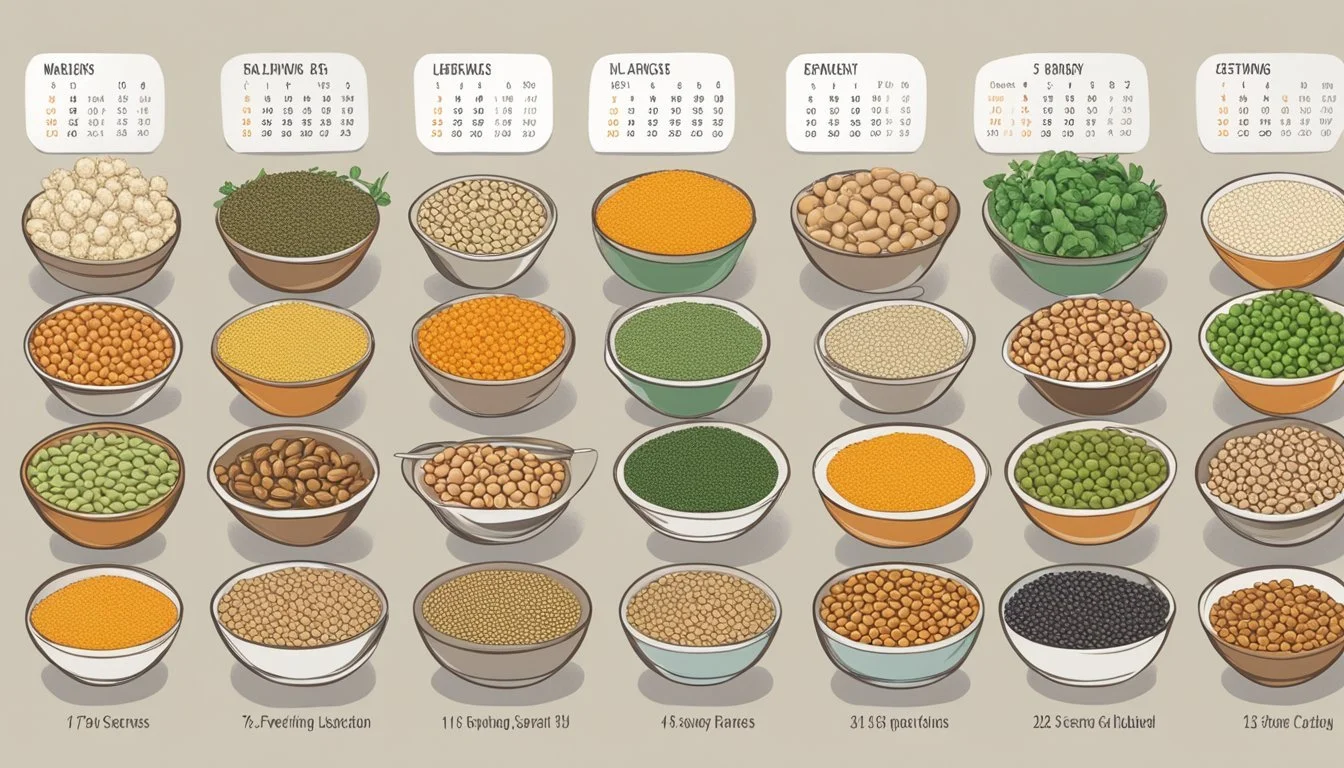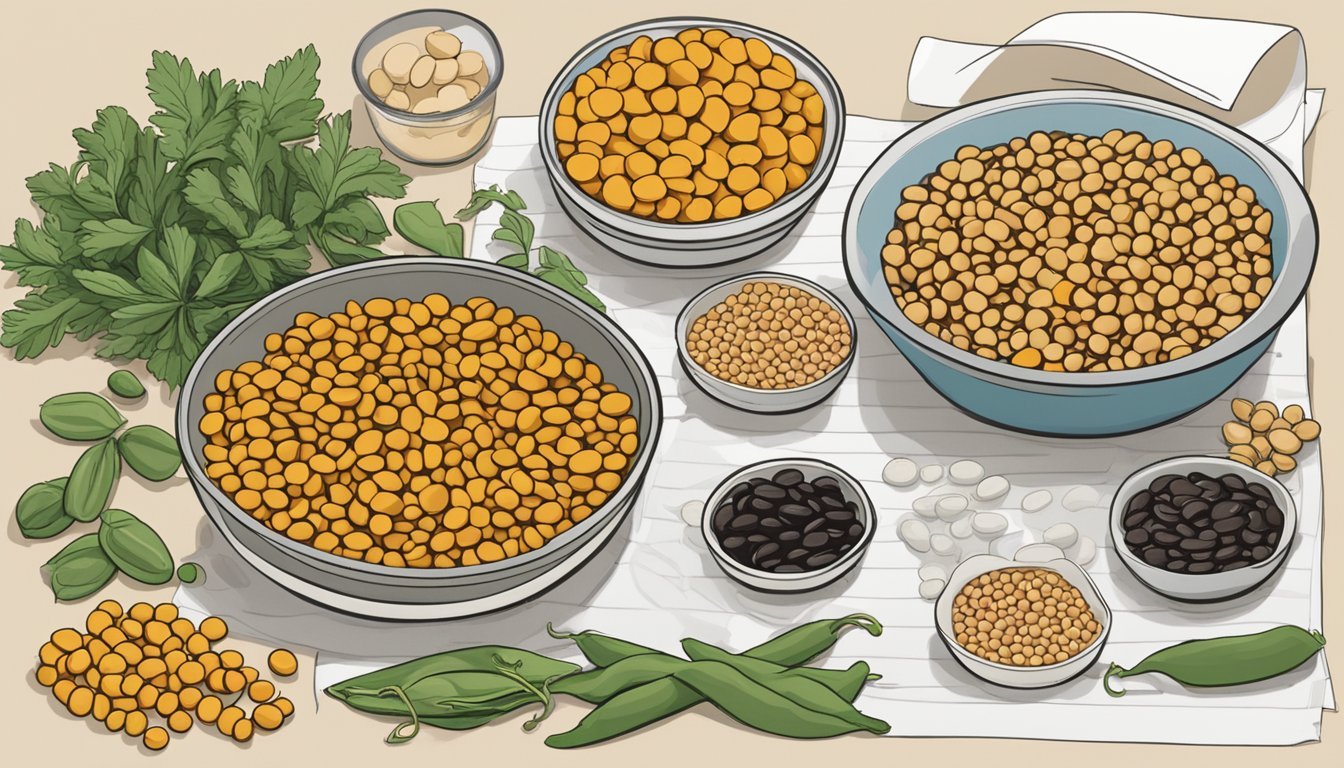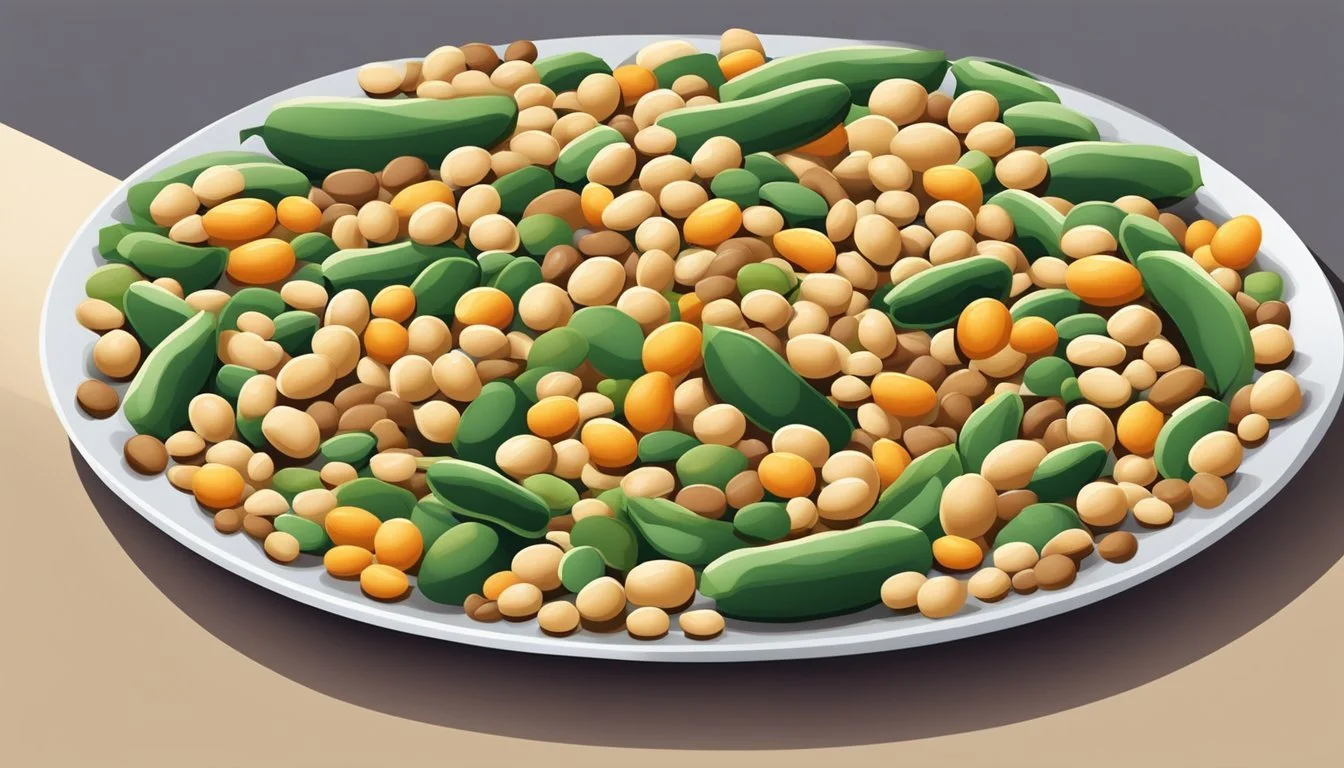How Many Servings of Legumes Should You Eat Per Week for Optimal Health?
Legumes are a diverse group of plant foods that include beans, lentils, peas, and chickpeas, and they are gaining recognition for their array of health benefits. Rich in protein, dietary fiber, and various vitamins and minerals, legumes are often recommended as a staple in a variety of dietary patterns. Beyond their nutritional value, they are also valued for their role in sustainable agriculture as they have the ability to fix nitrogen in the soil, reducing the need for chemical fertilizers.
Research suggests that incorporating legumes into one's diet can contribute to improved overall health. They are known to support heart health, aid in weight management, and may even reduce the risk of certain chronic diseases. The American Heart Association and other health organizations endorse the consumption of legumes as a way to obtain essential nutrients and to foster healthy eating patterns.
Although the specific recommended quantity of legume consumption can vary based on dietary guidelines and individual dietary plans, there is a general consensus that including them in the weekly diet can be beneficial. For instance, the Mediterranean diet, praised for its association with longevity and reduced risk of heart disease, recommends at least three servings of legumes per week. While exact serving sizes may differ, a standard serving of cooked legumes is typically understood to be half a cup. Increasing the intake of legumes, while balancing with other food groups, is an approachable goal for those looking to enhance their diet.
Defining Legumes and Their Role in the Diet
Legumes, a category within the plant family Fabaceae, include a variety of nutrient-dense foods such as beans, peas, lentils, and chickpeas. These staples feature prominently in dietary guidelines due to their health benefits. Rich in protein, legumes serve as an essential protein source, especially in plant-based diets.
Nutritional Composition of Legumes (average per 100g):
Protein: 20-25g
Dietary Fiber: 15-30g
Complex Carbohydrates: 60% of total composition
Legumes also offer essential micronutrients like iron, magnesium, and B-vitamins, supporting various bodily functions from oxygen transport to energy metabolism. Their role in the diet extends to managing chronic conditions; the consumption of legumes can contribute to improved glycemic control and lipid profiles, which are key factors in the prevention and management of diabetes.
Furthermore, legumes have a low glycaemic index (GI), indicating they raise blood sugar levels more slowly, which can be beneficial for weight management and overall metabolism. Additionally, their dietary fiber content promotes satiety and gut health.
Considering their environmental sustainability, legumes are recognized not just for their nutritional value but also for their role in sustainable food systems. They have a nitrogen-fixing ability that enriches soil health, making them a favorable choice in crop rotations and reducing the need for synthetic fertilizers.
In summary, legumes are versatile, nutritious components of the diet with multifaceted benefits that support health and environmental sustainability.
Recommended Servings of Legumes
Incorporating legumes into one's diet is key for heart health, providing essential nutrients and fiber. Dietary recommendations suggest specific serving frequencies to maximize health benefits.
General Dietary Guidelines
Legumes, which include beans, lentils, and peas, are recognized for their contribution to a healthy diet. They are not only rich in protein but also in fiber and essential minerals. For heart health maintenance, the American Heart Association and global dietary guidelines recommend legumes as a regular part of one's diet. Specifically, it is suggested that individuals consume legumes at least twice a week. These guidelines are based on a combination of research and traditional dietary patterns observed to be beneficial.
Legume Serving Sizes
When discussing serving sizes, clarity is crucial. Here is a concise breakdown of what constitutes a single serving of legumes:
Cooked beans, lentils, peas: 1/2 cup
Hummus or bean dip: 1/4 cup
These servings can be integrated into meals in various ways—added to salads, soups, and pasta dishes or as a base for spreads and dips like hummus. Serving sizes ensure adequate consumption without overindulgence, aligning with nutritional balances needed for a healthy diet.
Legumes and Health Outcomes
Legumes, a cornerstone in various diets, possess notable qualities that influence health outcomes, particularly regarding cardiovascular disease, diabetes, and cancer.
Cardiovascular Health
Legumes, including beans, lentils, and peas, are potent sources of fiber and phytochemicals that support heart health. They are associated with lowering LDL cholesterol (bad cholesterol), which is a key risk factor for heart disease. Diets rich in legumes correlate with a reduced incidence of cardiovascular disease due to their low glycemic index and ability to modulate blood pressure.
Diabetes and Blood Pressure
Regular consumption of legumes can support blood glucose control, an important consideration for individuals with, or at risk for, diabetes. Their high fiber content contributes to a lower glycemic index, beneficial for maintaining stable blood sugar levels. Additionally, legumes provide potassium and are low in sodium, which helps in managing blood pressure and may reduce the risk of developing hypertension.
Cancer Prevention
A diet inclusive of legumes may offer protection against certain types of cancer. The fibers found in legumes can aid in digestive health and may lower the risk of colorectal cancer. Their array of antioxidants and anti-inflammatory properties further enhance their cancer-preventive potential. Studies have suggested that eating legumes regularly could be part of a dietary strategy to reduce the risk of cancer-related mortality.
Nutritional Profile of Legumes
Legumes are a powerhouse of nutrition, offering a variety of essential nutrients that are crucial for maintaining good health. They are particularly renowned for their high protein content, making them a staple source of plant-based protein that is beneficial for vegetarians and vegans.
Fiber is another key component found abundantly in legumes. This indigestible carbohydrate aids digestive health, helps regulate blood sugar levels, and can contribute to a feeling of fullness, which is useful for weight management.
When it comes to vitamins, legumes are a significant source of B-vitamins, especially folate (vitamin B9), which is essential for cell growth and the formation of DNA. An adequate intake of folate is particularly important during pregnancy to prevent neural tube defects in infants.
In terms of minerals, legumes are an excellent source. They provide essential minerals such as magnesium, which is involved in over 300 biochemical reactions in the body including muscle and nerve function, blood glucose control, and blood pressure regulation.
Here is a breakdown of the key nutrients found in legumes:
Protein: A building block for muscles and tissues
Fiber: Supports digestive health and blood sugar balance
Folate: Essential for proper cell division and DNA synthesis
Magnesium: Plays a role in many physiological functions, including energy production, and supports bone health
Overall, legumes are not only versatile and environmentally sustainable but also nutritionally dense, making them an excellent inclusion in a balanced diet.
Incorporating Legumes into Meals
Legumes, a cornerstone of a healthy diet, are versatile and can be introduced into various meals with ease. They lend themselves to a wide range of cooking techniques, offer a plethora of recipe ideas, and serve as robust meat alternatives for those adhering to vegetarian diets.
Cooking Techniques
Legumes, encompassing beans, lentils, and peas, can be cooked in multiple ways to enhance their flavor and texture. Beans typically require soaking before cooking, which reduces cooking time and improves digestibility. To cook, one should:
Place soaked beans in a saucepan and cover with water.
Bring to a boil, then simmer until tender, which can take between 45 minutes to 2 hours depending on the bean type.
For lentils and split peas, the process is more straightforward since they do not require soaking:
Rinse thoroughly then simmer in water until tender, usually around 25 to 45 minutes.
Recipe Ideas
There are countless ways to integrate legumes into daily meals. Here are a few simple ideas to get started:
Salads: Toss cooked or canned beans into greens for added protein and texture.
Type of Legume Suggested Salad Type Chickpeas Mediterranean salad Kidney beans Southwest-style salad Black beans Taco salad
Hummus & Dips: Puree chickpeas or other beans to create a smooth hummus or bean dip, perfect for snacking with vegetables.
Soups & Stews: Add bulk and nutrition to soups and stews with a helping of legumes.
Legumes as Meat Alternatives
Those opting for vegetarian choices can use legumes as protein-rich meat substitutes.
Tacos: Substitute ground meat with cooked lentils or black beans.
Dish Meat Substitute Meatballs Lentils Bolognese Finely chopped mushrooms and beans Burgers Mashed chickpeas
This approach not only aligns with vegetarian principles but also contributes to a diverse and healthy diet.
Understanding Legume Allergies and Intolerances
Legumes, comprising beans, lentils, peas, and peanuts, are often associated with food allergies and intolerances, with peanuts being one of the most common allergens. Individuals with a sensitivity to legumes may experience a range of symptoms, from mild to severe.
Common Symptoms of Legume Allergies:
Itching or tingling of the skin
Hives (skin rashes or welts)
Swelling of the face, throat, or mouth
Gastrointestinal discomfort (nausea, vomiting, cramps)
Respiratory issues (asthma, wheezing)
Allergies to peanuts, a legume often used in various forms of cuisine, can trigger anaphylaxis, a potentially life-threatening condition. Soybeans, another legume, are also recognized as a common allergen in the United States.
It is essential for individuals with legume allergies to read ingredient labels carefully, as beans and peas are frequently included in "free-from" and gluten-free products to substitute egg and gluten. This can present challenges for those with legume allergies.
The cross-reactivity between legumes can vary. While some individuals may react to multiple legumes, others might only be sensitive to one type. For example, being allergic to peanuts does not necessarily imply an allergy to other legumes like lentils. However, due to the potential for cross-reactivity, caution should be exercised, and one should consult with an allergist.
Managing Legume Allergies:
Avoidance of legumes confirmed to cause allergic reactions
Reading food labels to identify legume content
Carrying emergency medication, such as epinephrine, if prescribed
Individuals who suspect they have a legume allergy or intolerance should seek professional medical advice for testing and guidance on managing their condition.
Comparison of Legumes with Other Food Groups
Legumes offer unique nutritional benefits that differentiate them from grains, starchy vegetables, dairy, and animal proteins. This section compares the nutritional profiles and roles of legumes relative to these food groups in a balanced diet.
Legumes vs. Grains and Starchy Vegetables
Legumes, such as lentils and beans, are often grouped with grains and starchy vegetables due to their carbohydrate content. However, legumes provide a higher protein content compared to grains like wheat and rice, and starchy vegetables such as potatoes and sweet potatoes.
Grains:
Whole grains: Rich in fiber and essential nutrients but lower in protein.
Bread: Common grain product, varies in nutritional value based on processing.
Starchy Vegetables:
Potato: High in carbohydrates, lower in protein compared to legumes.
Sweet potato: Nutrient-rich, offering vitamins A and C, but lower protein than legumes.
Food Group Protein Content Fiber Legumes High High Whole Grains Moderate High Bread (refined) Low Low Starchy Vegetables Low Moderate
Legumes tend to be superior in providing a balanced macronutrient distribution and can serve as a staple in vegetarian and vegan diets where meat, a primary protein source, is not consumed.
Legumes vs. Dairy and Animal Proteins
Legumes provide plant-based protein, while dairy products and animal proteins are primary sources of animal-based protein. The latter includes meat, poultry, eggs, cheese, and yogurt.
Dairy Products:
Cheese: High-calorie, contains calcium and protein but can be high in saturated fat.
Milk and yogurt: Provide protein and calcium, with yogurt offering probiotic benefits.
Animal Proteins:
Meat: Includes a range of protein contents, with lean meat being lower in fat.
Poultry: Generally lower in fat compared to red meat, and a good protein source.
Eggs: High in protein and nutrients, but also in cholesterol.
Food Group Protein Content Saturated Fat Cholesterol Legumes Moderate Low None Dairy Products High Variable Present Lean Meat High Low Present Poultry High Low to Medium Present Eggs High Medium High
Legumes are a cholesterol-free protein alternative, making them appealing for those managing cardiovascular health. They also contribute to a feeling of fullness and can be used effectively in weight management.
Impact of Legumes on Environmental Sustainability
Legumes, such as beans, lentils, and peas, are recognized for their environmental benefits. Their unique ability to fix atmospheric nitrogen, thanks to the symbiotic bacteria in their root nodules, reduces the need for synthetic nitrogen fertilizers. This nitrogen fixation enriches the soil, which benefits subsequent crops and helps maintain soil health.
They emit significantly lower greenhouse gases (GHG) compared to other protein crops. Research shows legumes release 5-7 times less GHG per unit area.
Legumes support carbon sequestration in soils. Estimates suggest values ranging from 7.21 g kg−1 of dry matter, contributing to reduced atmospheric CO2 levels.
By enhancing biodiversity, legumes promote the presence of various organisms in the agro-ecosystem, which has positive spillover effects on ecological balance.
Here's how legumes contribute to sustainability:
Aspect Contribution Nitrogen Fixation Reduces need for fertilizers GHG Emissions Lowers emissions significantly Carbon Sequestration Aids in reducing atmospheric CO2 Biodiversity Enhances ecosystem health
Legumes are seen as a vital component in shifting towards sustainable agriculture. Their growth requires less water than animal protein sources and typically fewer chemical interventions, leading to less agricultural runoff and reduced impact on freshwater ecosystems.
These characteristics of legumes underscore their role in promoting environmental sustainability. By incorporating legumes into crop rotations, farmers can achieve a more environmentally friendly and sustainable agricultural practice.
Choosing and Storing Legumes
When selecting legumes, individuals have the option of either dry or canned varieties, each with specific storage requirements to maintain freshness. Proper storage ensures the legumes retain their nutritional quality and are safe for cooking.
Dry vs. Canned Options
Dry Legumes:
Variety: They come in numerous types, including lentils, beans, and peas.
Preparation: Require soaking in water, often overnight, before cooking to ensure tenderness.
Cost-effectiveness: Generally more affordable and have a longer shelf life.
Canned Legumes:
Convenience: Pre-cooked and ready to use, making them a time-saver.
Texture: Softer than dried legumes post-cooking.
Sodium Content: Typically higher due to preservatives, but can be reduced by rinsing them in water before use.
Storage Tips
Dry Legumes:
Environment: Store them in a cool, dry place away from light. A pantry or a dark cabinet is ideal.
Container: Use an airtight container to keep moisture and pests out.
Shelf Life: Can last up to two years if stored properly, but it's best to use them within one year for optimal taste and cooking time.
Canned Legumes:
Unopened: Store in a cool, dry place. A cabinet or a pantry works well.
Opened: Transfer any leftovers to a container, cover with water, and refrigerate. Use within 3-4 days.
Freezing: Can be frozen for long-term storage. Drain and rinse before freezing to help reduce sodium.
Special Considerations for Different Populations
Eating habits and dietary needs can vary significantly across different population groups. It is essential to tailor legume consumption to meet the nutritional requirements of specific demographics, such as children or those following plant-based diets.
Legumes for Children
Children's diets must include a variety of nutrients to support their rapid growth and development. Legumes are a rich source of protein, fiber, and various micronutrients crucial for children. They are recommended as part of a balanced diet from an early age. However, portion sizes should be adjusted for younger children due to their smaller stomach capacity and lower calorie requirements when compared to adults. A suitable portion for a child may be 1/4 to 1/2 cup of cooked legumes, and they should be offered legumes regularly throughout the week, aiming for at least two servings.
Legumes in Plant-Based Diets
Individuals following vegetarian or vegan diets rely on plant-based foods as their primary source of nutrients. Legumes become an even more critical component of their diet, serving not only as a staple source of plant-based protein but also as a provider of essential amino acids typically sourced from animal products. Vegetarians and vegans should aim for at least two to three servings of legumes per day. This higher frequency ensures adequate intake of protein, iron, zinc, and B vitamins.
Serving Examples for Vegetarian & Vegan Adults:
1/2 cup cooked beans, lentils, chickpeas
1/2 cup cooked peas
1/4 cup peanuts or soy nuts
In any case, it is always advised to consult with a healthcare professional or a dietitian to determine the most appropriate serving sizes and frequency for legumes, tailored to an individual's specific dietary needs and health goals.
Conclusion
Legumes, such as beans, lentils, and peas, are recognized for their rich nutritional content and potential health benefits. They are high in vitamins, minerals, fiber, and phytochemicals, while being naturally low in fat. Additionally, legumes have a low glycemic index (GI), making them a beneficial food choice for blood sugar regulation.
Recommended consumption: Incorporating legumes into the diet at least 2-3 times per week is advisable. However, aiming for three or more servings a week can optimize the health benefits.
Serving size: A standard serving size of cooked legumes is about 150-200 grams, which is roughly equivalent to 70-100 grams of dry pulses.
The consistent inclusion of legumes in meals might reduce the risk of chronic diseases such as cardiovascular disease, certain cancers, and diabetes. Despite their benefits, consumption of legumes is relatively low among the population, suggesting a need for inclusive dietary guidance to promote their intake.
Nutrient Benefit Fiber Supports digestion and satiety Protein Essential for muscle repair and growth Phytochemicals May lower disease risk
Legumes should be part of a balanced diet, and individuals can enjoy a variety of legumes to harness the array of nutrients they provide. By adhering to the suggested frequencies and serving sizes, individuals can contribute to their overall health and well-being through regular legume consumption.






